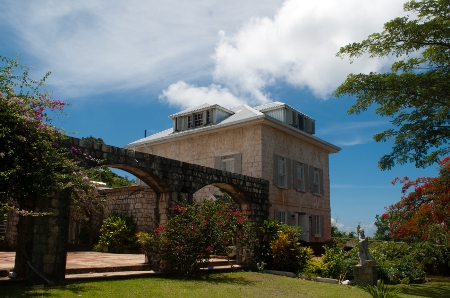Orange Park
Parish: St. Thomas

Orange Park which is located in the hills of Yallahs, St. Thomas, was once a coffee plantation. In Jamaica, coffee rarely competed with cane, as the latter was confined to the lowlands and the former to the mountains. It was very rare for the two crops to be produced on a single property.
Some of the earliest records for the Orange Park plantation show that in 1821 the property was owned by John Dick and Richard Dick and produced 62 tierces of coffee for export to London. By 1839 the property was owned by George Taylor and comprised 515 acres, of which 110 acres was under coffee cultivation and 326 acres designated woodland, ruinate, negro grounds, roads, gullies and works. At that time, the Great House stood on 33 acres of the total land.
In 1847, Orange Park produced coffee and pimento for export and sold cattle amounting to 115 pounds sterling to plantations. The property was then owned by William P. George. By 1882, Orange Park comprised 473 acres - 470 acres wood and ruinate and 3 acres ground provisions. The property was at the time owned by Robert Sylvester. The land usage indicates that by 1882 coffee cultivation had ceased on the Orange Park property.
The List of Property Returns revealed that in 1920, Orange Park was owned by C. A. Williams and the 400 acre property was uncultivated.
Orange Park has been the home and workshop of artist, Basil Barrington Watson for over 30 years. Between 1920 and 1969 there is no documentation of the acreage of the Orange Park property. At the time of its acquisition by Watson the size of the property was significantly reduced.
The property has a main house, two tennis courts, three studio cottages, and a main studio which is filled with some of the artist's most prized paintings and antique furniture. According to one writer, Watson has demonstrated by his life's work a commitment to contribute to the realisation in Jamaica that art is not only an expression of human creativity but also an aid to the cultivation of human sensibility and consequently to a more humane and civil society.
Watson was born on January 9, 1931, in the town of Lucea, Hanover. At the age of sixteen, he decided that he would become an artist. After leaving Kingston College, Watson worked for two years, with one aim in view, to save enough money to go to art school abroad and so bring his dream of becoming an artist to fruition. Watson was eventually educated at the London School of Printing and Graphic Art and the Royal College of Art in London; Rijicks Academy in Holland; Academic de la Grande Chaumiere, Paris; Academic de Belle Arti, Rome and Academia de las Bellas Artes, Madrid. In 1962 Watson returned to Jamaica, and in 1967, he forsook the security of a job and the prestige of being Director of Studies of the Jamaica School of Art to become a full-time artist.
Watson's presence at Orange Park has transformed the old coffee plantation into a meeting place for artists and art lovers. Watson commented that the property has been a rendezvous for several distinguished artists including the late Edna Manley who in speaking of it said "this is a creative place".
The Prime Minister, Hon. P.J. Patterson, accepted the title from Watson on behalf of the people of Jamaica. The Prime Minister in turn, handed the title over to Ainsley Henriques, then chairman of the Jamaica National Heritage Trust.
References:
- Barry Higman Jamaica Surveyed (Kingston:Institute of Jamaica Publications Ltd., 1988)
- Crop Accounts 1821, Jamaica Archives
- A Plan of Orange Park Coffee Plantation 1839, National Library of Jamaica
- Crop Accounts 1847, Jamaica Archives
- Return Of Properties 1882, Jamaica Archives
- Return of Properties 1920, Jamaica Archives
- B/N Basil Barrington Watson, National Library of Jamaica Files
- The Gleaner, Friday August 5, 1994
SHOWCASE
|
SHOWCASE
|
SHOWCASE
|


